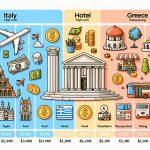Are you planning a trip to Europe but aren’t sure whether it’s cheaper to travel to Spain or Italy? In this article, we’ll explore the cost of traveling to these two popular destinations and help you determine which one may be more budget-friendly for your next vacation. From accommodation and transportation expenses to dining and food costs, we’ll compare the overall expenses of visiting Spain and Italy, including currency exchange rates and budget travel tips.
When it comes to planning a trip abroad, one of the first considerations is often the cost. So, is it cheaper to travel to Spain or Italy? Let’s delve into the various aspects of travel expenses in both countries and see how they stack up against each other.
We’ll start by comparing the cost of accommodation in Spain and Italy, including hotel and Airbnb prices. Then, we’ll analyze transportation expenses such as flights, trains, and buses in both countries. After that, we’ll delve into dining and food costs, as well as attractions and activities.
And finally, we’ll take a closer look at currency exchange rates and provide some money-saving strategies for exploring Spain and Italy on a budget. With all these factors considered, you’ll be better equipped to decide which destination offers a more affordable travel experience for you.
Cost of Accommodation
When comparing the cost of accommodation in Spain and Italy, travelers will find that both countries offer a range of options to suit different budgets. The prices of hotels and Airbnbs vary depending on the city or region, as well as the time of year.
In general, Italy tends to be more expensive than Spain when it comes to accommodation, especially in popular tourist destinations such as Rome, Florence, and Venice. However, there are still affordable options available in both countries.
In Spain, the cost of accommodation can be relatively lower compared to Italy, particularly in cities like Barcelona, Madrid, and Seville. Budget travelers can find affordable hotels and reasonably-priced Airbnbs without compromising comfort and convenience. On the other hand, Italy’s famous cities often command higher prices for accommodations due to their popularity among tourists. However, smaller towns and rural areas may offer more budget-friendly options for those looking to save on lodging expenses.
It is also important to consider the type of accommodation when comparing prices between Spain and Italy. While hotels may be more expensive in Italy, Airbnb can sometimes provide a more affordable alternative for travelers who prefer a homier atmosphere or want access to a kitchen for meal preparation.
Additionally, hostels are another option for budget-conscious travelers looking to save on accommodation costs while exploring both countries. Overall,is it cheaper to travel to spain or italy will depend on various factors including location, time of year and preferred type of lodging.
| Accommodation Type | Price Range (Per Night) |
|---|---|
| Hotel (Spain) | $50 – $150 |
| Hotel (Italy) | $80 – $200 |
| Airbnb (Spain) | $40 – $120 |
| Airbnb (Italy) | $60 – $150 |
Transportation Expenses
When comparing transportation expenses, it is important to consider the cost of flights, trains, and buses in both Spain and Italy. The cost of flights can vary depending on the time of year and how far in advance you book your tickets. In general, flights within Spain tend to be more affordable than those within Italy due to the country’s larger size and more extensive rail network.
In terms of train travel, both Spain and Italy offer extensive railway systems that connect major cities and regions. The cost of train tickets in Italy is often higher than in Spain, especially for high-speed trains such as the Frecciarossa. However, there are also more budget-friendly options available such as regional trains or advance purchase tickets. In Spain, the Renfe network offers a variety of ticket options including discount cards for frequent travelers.
When it comes to bus travel, both countries have well-developed bus networks that provide affordable transportation between cities and towns. Bus fares in Spain tend to be slightly lower than those in Italy, making it a more budget-friendly option for travelers looking to save on transportation expenses.
Overall, while there are variations in transportation costs between Spain and Italy, budget-conscious travelers have options for affordable travel within both countries.
| Transportation | Cost Comparison |
|---|---|
| Flights | Spain tends to offer more affordable domestic flights compared to Italy. |
| Trains | Italy’s high-speed trains may be pricier than those in Spain, but both countries offer budget-friendly options. |
| Buses | Bus fares in Spain are generally lower than those in Italy, making it a cost-effective mode of transportation. |
Dining and Food Costs
When it comes to the cost of dining and food, Spain and Italy offer a variety of options for travelers. From sampling local cuisine at restaurants to preparing meals at home, the prices can vary depending on where you are in each country.
Eating Out
In both Spain and Italy, dining out can be an enjoyable experience, but the costs may differ. While Spain is known for its tapas and affordable meals at local restaurants, Italy is famous for its pasta, pizza, and gelato. In general, eating out in Spain tends to be more budget-friendly compared to Italy. However, popular tourist areas in both countries may have higher prices due to increased demand.
Grocery Shopping
For travelers looking to save money on food expenses, grocery shopping is a great option. In Spain, supermarkets offer a wide range of products at reasonable prices, making it convenient for budget-conscious travelers to purchase ingredients for meals. Similarly, Italy has markets and grocery stores where visitors can buy fresh produce, cheese, and other items for cooking their own meals. Overall, grocery shopping in both countries offers opportunities to eat well without breaking the bank.
Considering the cost of dining out and grocery shopping in Spain and Italy is essential when determining which country may be cheaper to travel to. Whether you prefer sampling local dishes at restaurants or cooking your own meals while abroad will ultimately impact your overall expenses during your trip.
Ultimately when comparing the prices of eating out and grocery shopping in Spain and Italy
Attractions and Activities
When deciding between traveling to Spain or Italy, it’s important to consider the cost of sightseeing and entertainment in both countries. Each destination offers a wide range of attractions and activities for travelers to explore, but the price can vary significantly between the two. Below is a comparison of the costs associated with sightseeing and entertainment in Spain and Italy.
In Spain, there are numerous iconic landmarks and cultural attractions that visitors can explore. From the historic streets of Barcelona to the ancient Alhambra Palace in Granada, there is no shortage of things to see and do. Many of these attractions offer affordable entrance fees, making it easier for budget-conscious travelers to experience the country’s rich history and culture.
Italy is equally filled with world-renowned sights, including the Colosseum in Rome, the canals of Venice, and the art-filled streets of Florence. While some of these attractions may have higher entrance fees compared to those in Spain, they offer an unparalleled experience that many travelers find well worth the investment.
When it comes to entertainment, both Spain and Italy offer vibrant nightlife scenes, traditional performances, and local festivals throughout the year. Whether you’re interested in flamenco dancing in Sevilla or attending an opera at La Scala in Milan, there are opportunities for entertainment that cater to various interests and budgets. Ultimately, determining whether it is cheaper to travel to Spain or Italy depends on individual preferences and priorities when it comes to sightseeing and entertainment expenses.
Currency Exchange Rates
When planning a trip to either Spain or Italy, one crucial factor to consider is the currency exchange rates and how they will impact your travel expenses. Understanding how the Euro compares to the US Dollar can help determine which destination may be more budget-friendly for your trip.
To give you an idea of how the Euro stacks up against the US Dollar, here is a comparison of the current exchange rates for both currencies:
- 1 Euro (EUR) = 1.18 US Dollars (USD)
- 1 US Dollar (USD) = 0.85 Euros (EUR)
This means that if you are traveling from the United States, your money will go further in either Spain or Italy than it would have in previous years when the exchange rate was less favorable. However, it’s still important to factor in this exchange rate when creating a budget for your trip.
When it comes to exchanging currency for your trip, it’s best to do so at reputable banks or currency exchange offices to ensure you get a fair rate. Avoid exchanging money at airports or hotels, as they often charge higher fees and offer less favorable rates.
Another tip is to keep an eye on the currency exchange rates leading up to your trip, as they can fluctuate over time. This will allow you to buy foreign currency when the rate is most favorable, ultimately saving you money on your travel expenses.
Budget Travel Tips
When it comes to traveling on a budget, there are several money-saving strategies that can help visitors explore Spain and Italy without breaking the bank. From finding affordable accommodations to taking advantage of local transportation options, there are various ways to make the most of your travel budget in these popular European destinations.
Affordable Accommodations
One of the biggest expenses while traveling is accommodation. In both Spain and Italy, options like hostels, guesthouses, and budget hotels can provide comfortable stays at a fraction of the cost of luxury hotels. Additionally, booking accommodations outside of major tourist areas or during off-peak seasons can lead to significant savings. For those looking for a more unique experience, renting an Airbnb or staying in a vacation rental can also be an affordable option.
Budget-Friendly Transportation
Transportation expenses can add up quickly when traveling, but there are ways to save money on getting around in Spain and Italy. Opting for regional trains instead of high-speed options or using buses for intercity travel can be more economical choices. Furthermore, purchasing transportation passes or city cards for unlimited public transit use in popular tourist cities can help reduce costs.
Cheap Eats and Dining Tips
Eating out at restaurants every meal can quickly eat into your travel budget. To save money on food costs in Spain and Italy, consider shopping at local markets and grocery stores for snacks and meals. Additionally, seeking out casual eateries away from tourist hotspots can often result in more affordable dining options. Visitors should also look out for lunch menus or set-price dinner specials offered by many restaurants to enjoy a good meal at a lower price point.
Overall, with careful planning and consideration of cost-effective options for accommodation, transportation, dining, and activities, it is possible to explore both Spain and Italy on a budget while still enjoying all the highlights each country has to offer. By implementing these budget travel tips, visitors can make the most of their travel funds and have a memorable experience in these beautiful destinations.
Conclusion
In conclusion, determining whether it is cheaper to travel to Spain or Italy involves considering a variety of factors such as accommodation, transportation, dining, attractions, and currency exchange rates. The cost of accommodation in both countries varies depending on the type of lodging chosen, with Airbnb often offering more affordable options compared to hotels.
Transportation expenses also differ between Spain and Italy, with flights, trains, and buses having varying costs. When it comes to dining and food costs, both countries offer a mix of inexpensive and pricier options for eating out and grocery shopping.
Moreover, the cost of attractions and activities can impact overall travel expenses as well. While some sights may have entrance fees, there are often free or discounted activities available for travelers on a budget. Additionally, currency exchange rates play a significant role in determining the affordability of traveling to Spain or Italy for those using the US dollar. It’s essential to consider how the euro compares to the US dollar when planning a trip to either country.
Overall, while both Spain and Italy offer unique experiences for travelers, it ultimately depends on individual preferences and budget constraints when deciding which country is cheaper to visit. By taking advantage of budget travel tips and thoroughly researching prices in each destination beforehand, travelers can make informed decisions about where to go based on their financial considerations.
Ultimately, answering this question “Is it cheaper to travel to Spain or Italy?” is not just about comparing overall expenses but also taking into account personal preferences and factors that are important for an enjoyable travel experience.
Frequently Asked Questions
What Is the Cheapest Month to Go to Spain?
The cheapest month to go to Spain is typically January or February. These months are considered the low season, so you can find better deals on accommodations and flights. Just be prepared for cooler temperatures.
Is Spain a Cheap Country to Visit?
Spain can be a relatively cheap country to visit, especially compared to other Western European destinations like France or Italy. You can find affordable accommodations, delicious yet budget-friendly food options, and plenty of free or low-cost activities to enjoy.
Is It Hotter in Spain or Italy?
Generally, Spain tends to be hotter than Italy due to its more southern location and Mediterranean climate. In the summer months, cities like Madrid and Seville can experience scorching temperatures, often reaching well above 90°F. Meanwhile, places in Italy like Milan or Florence may not get as hot but still have warm summers.

I’m a passionate traveler, writer, and Italophile. My fascination with Italy’s history, art, and culture has led me on countless adventures across the Italian landscape. Through “I Live Italy,” I share my love for this extraordinary country and aims to inspire others to explore its boundless beauty.




